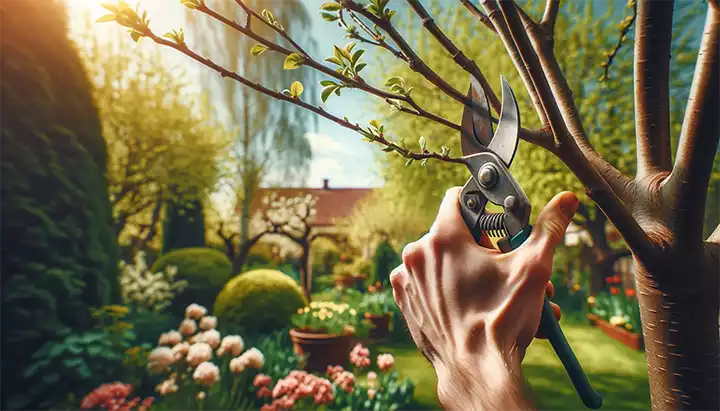The Art and Science of Pruning: A Comprehensive Guide
Pruning is a fundamental aspect of gardening, blending art with scientific principles to ensure trees and shrubs remain healthy, attractive, and productive. Effective pruning requires knowledge of plant biology and proper technique to achieve the best results. Here’s a detailed guide on understanding and applying pruning techniques.
Understanding Growth Buds
- Apical Dominance:
- Concept: Plants exhibit apical dominance, where growth is concentrated at the terminal bud, suppressing the development of lateral buds. This dominance helps the plant grow taller but can limit the spread of branches.
- Variation: Different species show varying degrees of apical dominance. For instance, vertical branches maintain strong apical dominance, while branches angled at 45° to 60° have reduced dominance, promoting lateral growth. Horizontal branches often lose apical dominance, leading to the formation of water sprouts.
- Growth Patterns:
- Orientation: Vertical limbs show vigorous growth at the tip, while lateral branches spread out more. Horizontal limbs, with less apical dominance, may produce numerous water sprouts, which are undesirable vigorous shoots that can sap energy from the plant.
Removing Heavy Branches
- Cut From Below:
- Technique: Start by making an undercut on the branch to prevent the bark from tearing as the branch falls.
- Cut the Branch Top:
- Technique: After the undercut, make a top cut beyond the first cut to remove the branch in a controlled manner.
- Cut to the Branch Collar:
- Technique: Finalize by cutting close to the branch collar—the swollen area where the branch connects to the trunk or main branch. Avoid cutting into the branch collar as it’s crucial for healing and reducing the risk of disease.
General Pruning Process
- Timing:
- Dormancy: Prune trees and shrubs during their dormant period, typically in winter or early spring. This minimizes stress and encourages robust growth.
- Flowering Shrubs: Prune flowering shrubs after they have bloomed to avoid removing next season’s buds.
- Specialty Pruning:
- Evergreens: Prune evergreens in early spring before new growth begins.
- Fruit Trees: Prune fruit trees to open up the canopy for better light penetration and air circulation, which improves fruit production and reduces disease risk.
- Roses:
- Timing: Prune roses in early spring. Cut back to healthy, live wood just above an outward-facing bud to encourage a balanced shape and abundant blooms.
Pruning Techniques
- Thinning:
- Purpose: Remove entire shoots back to their origin to reduce crowding and promote healthy growth. This technique maintains apical dominance and encourages growth at undisturbed tips.
- Water Sprouts and Suckers:
- Removal: Eliminate water sprouts (vigorous, upright shoots) and suckers (growth from the base) to prevent energy drain and guide the plant’s growth.
- Renewal Pruning:
- Objective: Prune older trees to improve air circulation and light penetration, fostering new growth and maintaining plant health.
- Crotches and Angles:
- Focus: Remove limbs with narrow-angled crotches as they are structurally weaker and more prone to damage. Aim for broader angles to enhance the tree’s stability.
Healing and Regrowth
- Healing:
- Process: Healing begins in the cambium layer, just beneath the bark. For optimal healing, prune close to the main branch without injuring the bark ridge or branch collar, which helps the plant recover more efficiently.
- Regrowth:
- Stimulus: Pruning stimulates new growth near the cut. More severe pruning typically results in more vigorous regrowth as the plant tries to restore balance between the top growth and root system.
Summary
Pruning is more than just cutting back growth; it involves understanding the plant’s biology and growth patterns. Proper pruning promotes healthy growth, enhances aesthetic appeal, and prevents disease and damage. By mastering pruning techniques and timing, gardeners can maintain vibrant, well-structured plants that enhance the beauty and functionality of their landscapes. 🌳✂️
